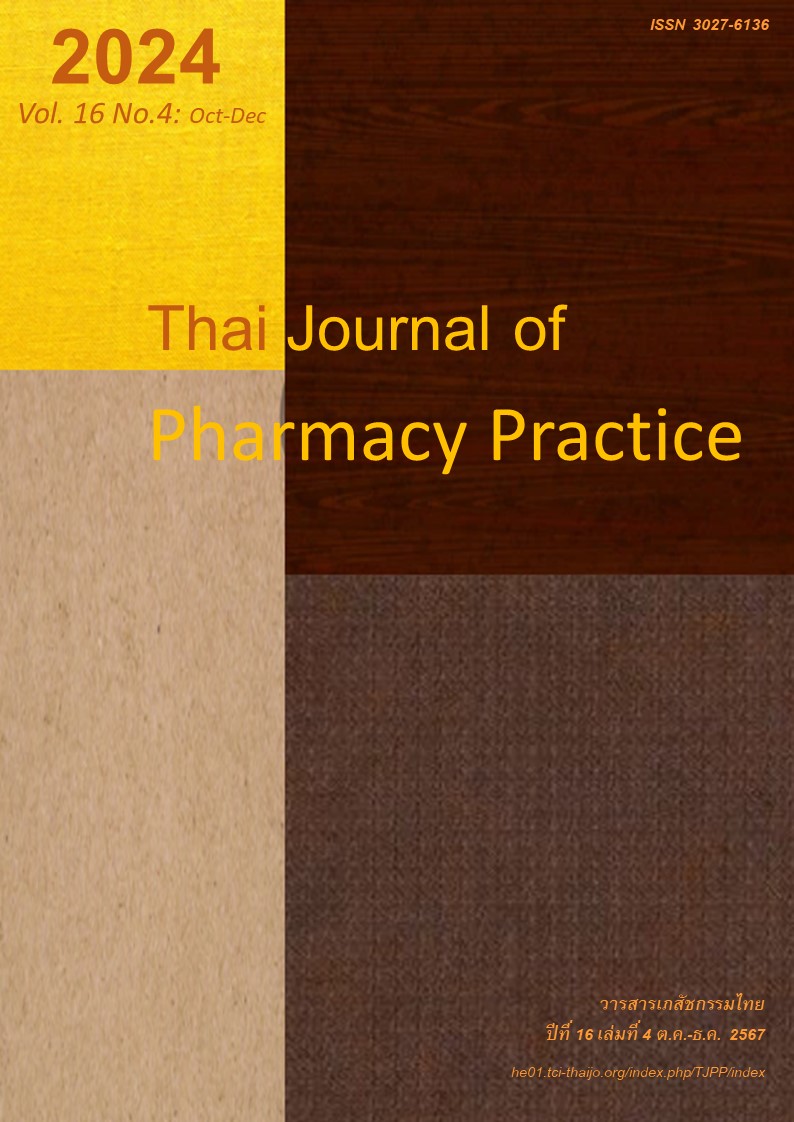ความร่วมมือในการใช้ยาและความสัมพันธ์กับคุณลักษณะของผู้ป่วยเบาหวานชนิดที่ 2 ณ โรงพยาบาลจุฬาลงกรณ์
Main Article Content
บทคัดย่อ
วัตถุประสงค์: เพื่อประเมินความร่วมมือในการใช้ยาและหาความสัมพันธ์ระหว่างความร่วมมือในการใช้ยากับ คุณลักษณะของผู้ป่วยเบาหวานชนิดที่ 2 ณ โรงพยาบาลจุฬาลงกรณ์ วิธีการ: การศึกษาแบบภาคตัดขวางนี้ทำในผู้ป่วยนอกที่เป็นโรคเบาหวานชนิดที่ 2 จำนวน 152 คน ณ โรงพยาบาลจุฬาลงกรณ์ สภากาชาดไทย ระหว่างเดือนมกราคม ถึงเดือนมีนาคม 2566 การประเมินความร่วมมือในการใช้ยาใช้แบบสอบถามพฤติกรรมการใช้ยา Medication Taking Behavior Measure for Thai Patients (MTB-Thai) การเก็บรวมรวมข้อมูลทำโดยให้ผู้ป่วยตอบแบบสอบถามด้วยตัวเองหรือผู้เก็บข้อมูลอ่านคำถามให้ฟัง และยังรวบรวมข้อมูลจากเวชระเบียนของผู้ป่วย ผลการวิจัย: ผู้ป่วยร้อยละ 47.4 มีความร่วมมือในการใช้ยาระดับสูงโดยได้คะแนน MTB-Thai เต็ม 24 คะแนน คุณลักษณะของผู้ป่วยที่มีความสัมพันธ์ต่อความร่วมมือในการใช้ยา คือ สถานะภาพการจ้างงาน กลุ่มที่ไม่ได้ทำงานมีความร่วมมือในการใช้ยาสูงกว่ากลุ่มที่มีงานทำอย่างมีนัยสำคัญทางสถิติ (P < 0.05) ส่วนคุณลักษณะ อื่น ๆ ได้แก่ เพศ ระดับการศึกษา ระยะเวลาที่เป็นโรคเบาหวาน ปริมาณยาที่ใช้ต่อวัน อายุ และจำนวนโรคประจำตัว ไม่มีความสัมพันธ์กับความร่วมมือในการใช้ยา สรุป: ผู้ป่วยเบาหวานชนิดที่ 2 ในโรงพยาบาลจุฬาลงกรณ์ส่วนใหญ่มีความร่วมมือในการใช้ยาดี สถานะภาพการจ้างงานเป็นคุณลักษณะของผู้ป่วยที่มีความสัมพันธ์กับความร่วมมือในการใช้ยา
Article Details

อนุญาตภายใต้เงื่อนไข Creative Commons Attribution-NonCommercial-NoDerivatives 4.0 International License.
ผลการวิจัยและความคิดเห็นที่ปรากฏในบทความถือเป็นความคิดเห็นและอยู่ในความรับผิดชอบของผู้นิพนธ์ มิใช่ความเห็นหรือความรับผิดชอบของกองบรรณาธิการ หรือคณะเภสัชศาสตร์ มหาวิทยาลัยสงขลานครินทร์ ทั้งนี้ไม่รวมความผิดพลาดอันเกิดจากการพิมพ์ บทความที่ได้รับการเผยแพร่โดยวารสารเภสัชกรรมไทยถือเป็นสิทธิ์ของวารสารฯ
เอกสารอ้างอิง
International Diabetes Federation. IDF diabetes atlas, 10th ed [online]. 2021. [cited jun 1, 2023]. Available form: www.diabetesatlas.org.
Division of Non Communicable Diseases, Depart- ment of Disease Control. Number and death rate of 5 non-communicable diseases from 2017 - 2021 [online]. 2023 [cited Jun 1, 2023]. Available from: www.thaincd.com/index.php.
Diabetes Association of Thailand. Clinical practice guideline for diabetes 2017. 3rd ed. Bangkok: Romyen Media; 2017.
Hong JS, Kang HC. Relationship between oral anti- hyperglycemic medication adherence and hospitali- zation, mortality, and healthcare costs in adult ambulatory care patients with type 2 diabetes in South Korea. Med Care 2011; 49: 378-84.
Lin LK, Sun Y, Heng BH, Chew DEK, Chong PN. Medication adherence and glycemic control among newly diagnosed diabetes patients. BMJ Open Diabetes Res Care. 2017; 5: e000429.
Muliyil DE, Vellaiputhiyavan K, Alex R, Mohan VR. Compliance to treatment among type 2 diabetics receiving care at peripheral mobile clinics in a rural block of Vellore District, Southern India. J Family Med Prim Care. 2017; 6: 330-5.
Sendekie AK, Netere AK, Kasahun AE, Belachew EA. Medication adherence and its impact on glycemic control in type 2 diabetes mellitus patients with comorbidity: A multicenter cross-sectional study in Northwest Ethiopia. PLoS One. 2022; 17: e0274971.
Chan AHY, Horne R, Hankins M, Chisari C. The Medication Adherence Report Scale: A measure- ment tool for eliciting patients' reports of non- adherence. Br J Clin Pharmacol. 2020; 86: 1281-8.
Farmer KC. Methods for measuring and monitoring medication regimen adherence in clinical trials and clinical practice. Clin Ther 1999; 21: 1074-90.
Lam WY, Fresco P. Medication adherence measures: An overview. BioMed Res Int 2015; 2015: 217047.
Nassar RI, Basheti IA, Saini B. Exploring validated self-reported instruments to assess adherence to medications used: A review comparing existing instruments. Patient Prefer Adherence 2022; 16: 503-13.
Khankaew W, Thanaboonpuang P, Intana J. Selected factors affecting medication adherence among older patients with type 2 diabetes in Mueang District, Ratchaburi Province. Journal of Research for Health Improvement and Quality of Life 2021; 1: 1-12.
Mongkolchaipak T, Pichayapaiboon S, Sangviroon A. Factors affecting medication adherence of diabetic patients at Police General Hospital. Thai Journal of Pharmacy Practice. 2015; 7: 47-58.
Prompinit P, Phakdeekul W, Kedthongma W. Factors affecting medication adherence among type 2 diabetic patients in Songdao Hospital, Sakon Nakhon Province. Research and Development Health System Journal 2020; 13: 538-50.
Sakthong P, Chabunthom R, Charoenvisuthiwongs R. Psychometric properties of the Thai version of the 8-item Morisky Medication Adherence Scale in patients with type 2 diabetes. Ann Pharmacother. 2009; 43: 950-7.
Nunnally J, Bernstein I. Psychometric theory. 3rd ed. New York: McGraw-Hill; 1994.
Chantapattarakun P. Factors related to medication adherence among outpatients with type 2 diabetes and hypertension at NCD clinic, Bangsaphan Hospital, Prachuap Khirikan Province. Thai Journal of Clinical Pharmacy. 2023; 29: 13-24.
Jongwilaikasem K, Lerkiatbundit S. Development of the Medication Adherence Scale for Thais (MAST). Thai Journal of Pharmacy Practice 2021; 13: 17-30.
Sakthong P, Sonsa-Ardjit N, Sukarnjanaset P, Mun- pan W, Suksanga P. Development and psychometric testing of the medication taking behavior tool in Thai patients. Int J Clin Pharm 2016; 38: 438-45.
Rosner B. Multisample inference. In: Fundamentals of biostatistics. 5th ed. Pacific Grove, California: Duxbury Thomson Learning; 2000. p. 511-76.
Kirkman MS, Rowan-Martin MT, Levin R, Fonseca VA, Schmittdiel JA, Herman WH, et al. Determinants of adherence to diabetes medications: findings from a large pharmacy claims database. Diabetes Care. 2015; 38: 604-9.
Chin SS, Lau SW, Lim PL, Wong CM, Ujang N. Medication adherence, its associated factors and implication on glycaemic control in patients with type 2 diabetes mellitus: A cross-sectional study in a Malaysian primary care clinic. Malays Fam Physician 2023; 18: 14.
Shaha KC, Sultana S, Saha SK, Shahidullah SM, Jyoti BK. Patient characteristics associated with medication adherence to anti-diabetic drugs. Mymen singh Med J 2019; 28: 423-8.
Homrot S. Factors affecting medication adherence of type 2 diabetes patients in Bang Krathum Hospital, Phitsanulok Province [master thesis]. Phitsanulok: Naresuan University; 2020.
ElSayed NA, Aleppo G, Aroda VR, Bannuru RR, Brown FM, Bruemmer D, et al. Pharmacologic approaches to glycemic treatment: Standards of care in diabetes-2023. Diabetes Care. 2023; 46(Suppl 1): s140-s57.
Alshehri KA, Altuwaylie TM, Alqhtani A, Albawab AA, Almalki AH. Type 2 diabetic patients’ adherence towards their medications. Cureus. 2020; 12: e6932.
Wabe NT, Angamo MT, Hussein S. Medication adherence in diabetes mellitus and self management practices among type-2 diabetics in Ethiopia. N Am J Med Sci. 2011; 3: 418-23.
Khattab MS. Compliance and control of diabetes in a family practice setting, Saudi Arabia. East Mediterr Health J 1999; 5: 755-65.


